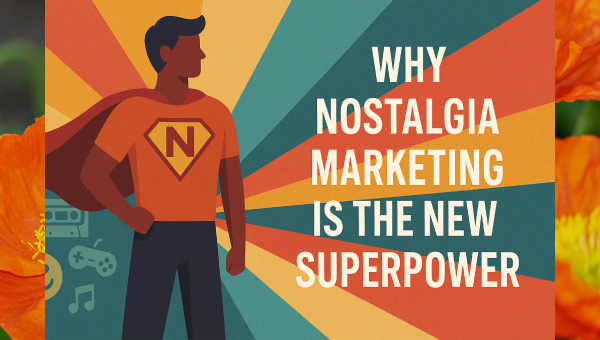Why Nostalgia Marketing Is the New Superpower

In a modern, hyper-digitized, and accelerated marketing environment, where trends come and go in almost a blink of an eyelid, a single emotional trigger has proved to be a lasting phenomenon: nostalgia. It doubles up the heartstrings, creates warm memory feelings, and creates strong emotional bonds between consumers and brands. In an age where customization and an emotional connection make all the difference, nostalgia marketing is not a strategy, but a superpower.
The Science of Nostalgia
Nostalgia is not only a cherished memory. Psychologists define it as a nostalgic yearning for the past, usually a time or a place that has pleasant personal memories. Feelings evoked by nostalgia may be warmth, comfort, security, and even strength to cope with the existing hardships. According to neuroscience, such instances of nostalgia stimulate the reward system in the brain and fill it with dopamine, the feel-good chemical.
This response can be very powerful in marketing. When nostalgic feelings are provoked through a brand, a consumer does not simply smile, but a neural imprint is created, which makes this experience more significant and memorable. This neuroscience of attachment creates brand loyalty, and trust much more powerfully than even purely rational communication.
Here is Why Nostalgia Marketing is So Effective Nowadays
These are some of the cultural and psychological reasons why nostalgia marketing has been getting more powerful over the past few years:
Excessive Contemporary Life
Consumers today are under unrelenting pressure: Technological change is accelerating, and the world is uncertain, socially turbulent, and information-saturated. It could be a trip down memory lane to the carefree childhood or the optimism of the 90s, either way, nostalgic content provides people with an emotional time out.
The brands that are able to harness this need to relax, to keep things simple, can provide a sort of emotional escape hatch to consumers, and they are flocking to them.
Cross-Generational Appeal
Nostalgia marketing ensures that several generations are targeted simultaneously. Millennials may get a twinge of pleasure at the sight of a reboot of a snack or a cartoon of the 90s, whereas Gen Z feels curiosity and a sense of retro-cool. In the meantime, Gen X and Baby Boomers are attracted to the aesthetics, music, or slogans of the bygone days.
This cross-generational participation gives marketers a chance to expand their demographic scope without separating their message.
The Remakes and Reboots Phenomenon
Nostalgia has been established as a mainstream trend, following the success of Hollywood reboots, retro video game systems and fashion, and other elements of the past. Streaming services are dominated by series that either revive old classics or are very much retro-inspired. Whether it is “Stranger Things” or Barbie, nostalgia is no longer a niche but has taken a prominent place, and brands are picking up on it.
When the consumer culture reprocesses the past in a new way, it creates rich soil on which marketers are welcome to enter the dialogue.
Nostalgia is Charged by Big Brands as Well
Several famous brands have already perfected the use of nostalgia marketing. They have used its power in the following ways:
- Coca-Cola: Nostalgia in Coca-Cola advertising is not new, yet the brand went a step further with its 2020 Sip & Scan campaign, which featured old holiday advertisements and retro bottle designs. This not only rekindled the emotional connection with older customers but also made the younger generations aware of the legacy of the brand.
- Nintendo: The NES and SNES Classic Editions were genius attempts by Nintendo to bring back its retro consoles, but in a limited quantity, which caused them to sell out globally. These little consoles did not only sell games, but they sold memories. Nintendo has made a profit out of the childhood of millions of people, making digital entertainment a journey of feelings.
- Nike: The Nothing Beats a Londoner and Air Jordan campaigns that are created by Nike have incorporated the retro aesthetic with a contemporary narrative. With its use of retro sneakers, old-school athletes, and a throwback to the motifs of the 80s/90s, Nike can evoke emotional appeals, as well as remain culturally relevant.
- Pepsi: The brand also revived its retro logo and celebrity-filled commercials in its Pepsi Generations campaign, targeting customers of the various decades. The campaign did not merely remind the people of the history of Pepsi, but it allowed them to re-experience pop culture benchmarks, which strengthened the familiarity and the identity of the brand.
Nostalgia Marketing Types
Various forms of nostalgia are exploited by marketers in order to evoke emotional associations. The best way to ensure that your message is inclusive is to try it with various groups and monitor the reaction of each group.
- Personal Nostalgia: That is when the brands connect to the personal memories of the consumers- such as a particular product they possessed as a child. Such as, when an old candy bar or toy is re-released it creates certain personal memories that are directly related to the brand.
- Historical Nostalgia: This appeals to wider collective memories of society such as the roaring 20s, the post-war 50s, or the disco-infused 70s. This method is employed by such brands as Levi’s or Harley-Davidson, which want to make people think of the mood of a generation, not of a particular memory.
- Mining the Pop Culture Memories: This strategy uses old TV programs, films, songs, and personalities to trigger emotional reactions. This can be seen in Spotify year-end Wrapped playlists which showcase what people listened to earlier in the year, or LEGO retro collaborations with Star Wars and Super Mario, which take cherished symbols and put them back into play in new, friendly forms.
- Retro-Branding: In this case, businesses bring back old logos, packaging, or jingles. It is common with product lines that are of a limited edition to create some excitement. The KFC brought back Colonel Sanders and the Burger King featured a throwback logo, both excellent implementations of retro-branding.
The Best Ways to Utilize Nostalgia Marketing
Nostalgia marketing is effective, but employing it effectively needs planning and cautiousness. That is how it can be used by brands:
- Know Your Audience Golden Era: Find out which period in time your target demographic identifies with. Millennials could relate to the old internet culture, Tamagotchis, and Pokemon, whereas Gen X might be inclined to cassette tapes, arcade games, and MTV. The way to strike the right emotional chords is through market research and audience stratification.
- Blend Past and Present: Not merely reviving the past but updating it in a contemporary way.Put a new spin on old products or designs to make them current. A successful instance is Polaroid which has recently presented vintage-style cameras with innovative features such as Bluetooth and digital backup.
- Narrate a Tale: Storytelling-based nostalgia campaigns are the most effective ones. Make use of visuals, songs, and real-life stories to emotionally piggyback on consumers. Nike advertisements have a tendency to do this a lot by displaying the past glory and the current dreams.
- Make Sharable Moments: The feeling of nostalgia is social. Your readers will be enthusiastic about posting content that can remind them of the past. Ask people to create their content or use a specific hashtag or challenge based on memories that allowed your audience to be a part of the nostalgia trend. Consider Spotify Wrapped or the Share a Coke campaign by Coca-Cola the campaigns access the memory of personal experiences and invite others to share their experience.
- Warnings and Predoutes: The phenomenon of nostalgia marketing, as powerful as it is, may fail spectacularly unless carefully approached. This is something to watch:
- Inauthenticity: When your brand is not affiliated with the period you are attempting to reference it can appear opportunistic. Consumers are quick to disappoint brands who seem to be, as they say, trying too hard, or hopping on a bandwagon without any authority.
- Over-Reliance: Innovation should not be wishful thinking of the past. Brands have to juggle between references to past and present value propositions. Relying on the past too much may cause a brand to appear old-fashioned or time-warped.
- Exclusion Risks: Nor is all nostalgia universal. A campaign that strongly appeals to one group can turn off another. To ensure your message resonates with all people, a good plan is to test the message with various audiences.
Nostalgia Marketing in the Future
With Gen Z and even younger generations acquiring spending power, the media they have been consuming since childhood will be the source of tomorrow morning nostalgia: early YouTube, first-generation iPhones, and TikTok memes. The use of nostalgia in marketing is here to grow, not to die. It will all come down to grasping the emotional territory that is specific to each generation and using technology to build immersive, personal experiences.
The use of virtual reality, AI, and augmented reality will probably give nostalgia campaigns an extra boost. Consider being in a position to virtually visit a VR model of your old high school, or see holographic projections of retro icons advertising your favorite soft drink. They are no longer the stuff of sci-fi fantasies, but they are the future of marketing.
Conclusion
Nostalgia marketing is not a selling of the memory only - it is an establishment of emotional ties in a fractured world. It gives continuity, identity, and warmth to an era that is most of the time cold and hectic. Brands that get this emotional resonance right do not simply achieve sales, they create legacies.
And, thus, unless you are reviving a dated logo, re-mixing an old jingle, or re-introducing a long-lost flavor, understand that you are not merely marketing. You're bringing people a part of their history (and that in the world of today perhaps that is the strongest thing of all).








